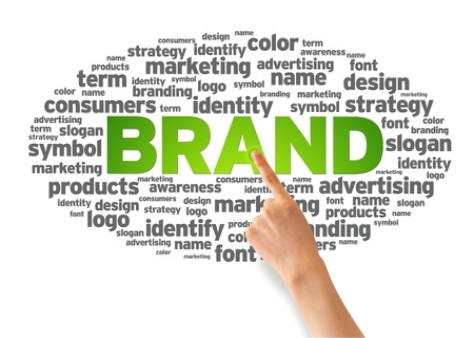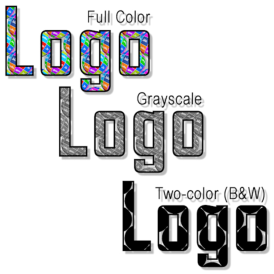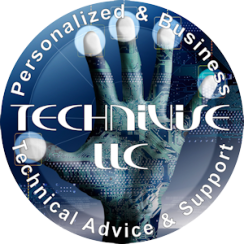Technivise Blog Article
This is a blog article from Technivise LLC. If you’d like to see other articles,
check out the Blog Index.


Branding your small business – 3 Practical categories to
consider for marketing
One of the first steps to take before addressing marketing and Online Presence is to think about brand. Like any other subject, it can be
complex in some situations, but focusing on the practical issues can help you find solutions or better understand the pros later when you
need help.
Technivise always inquiries about brand and branding with Small and Medium Businesses (SMB) before going too far promoting or
updating their businesses on the Internet and other means of advertising. Taking pause to consider brand can save time and money. This
blog presents a quick overview of critical concepts in branding so you’re better prepared to consider it in your Online Presence.
Brand
A brand can be thought of as a set of quick ways for customers to
recognize and remember your business, encourage loyalty, and
spread the word about your value. Brand is something you want to
protect! Your brand can become bad or negative if you get poor
customer reviews or negative events occur. Your brand can be stolen
or weakened by competitors or other detractors.
Your brand can be any number of elements that work separately or
together. Consider these as end-products of brand, but not where to
start: Logo, Symbol, Icon, Mark, Name, Word, Words, Font, Colors,
Location, Approach, Reputation. Other words connected to brand are
in the “BRAND” graphic here.
Some businesses have a strong brand concept while others do not.
That’s OK. You can add to or update what already exists. That is
called “Re-branding,” but we’ll save that for another time. If you look around the web about what “brand” means, you’ll get a wide range of
ideas. Specialty branding consultants may cost more than affordable by a small business. Fortunately, you can do much of this yourself and
Technivise can advise in these areas.
One way to think of branding is in three steps:
1.
Brand Promise – The big picture of your customer objectives,
2.
Brand Elements – How you express your brand,
3.
Working with Your Living Brand – What you do to use, support, and protect your brand.
(1) Brand Promise
In the big picture, “Brand Promise” is a current term for thinking about your goals before you ever think about a logo or color scheme.
Related terms are “brand identity” and “brand positioning statement.” Brand Promise quickly lets your potential and existing customers
how you will positively impact their lives – what you will do and how you will treat them. To do this, you should also know your customers.
What do they need? What are their preferences? A brand promise should distinguish your company from
others in your field with something customers care about. It’s about the customer, not you or your
company! You want your customers trust!
It’s worthwhile to think about and capture your Brand Promise in words or lists and then express them in
your branding elements. Consider what Brand Promise means to you and how to create statements about
your unique value to your customers and the policies you will have to take care of your customers. Once
you select initial branding elements, ask yourself if they support your Brand Promise.
(2) Branding Elements
Technivise considers a wide range of elements as part of your brand, many of them listed below. A particular business may not
adopt all of these, but should consider them all carefully. Others not listed here may be important for your business.
•
Quality: Differentiation - be different, unique
First consider the quality of being different in all or most of your branding elements. You don’t have to be completely unique – but you
should have some uniqueness claims. Don’t copy other companies branding. Look different. Be distinguishable from your competitors.
To do this, research or have Technivise consider what other companies are your competitors and which other companies have already
picked branding elements that may be similar to those you have or are considering. Consider the options and pick the best path.
•
Company name
If you have not yet named your company, a critical branding element will definitely be the company name! They should be simple to
remember and may also have some meaning to the customer. It should stand out from other companies.
If you already have a name for your company, can or should you alter it? Are you changing the focus or expanding your business?
While it is great to have a unique name nobody else has, if your business is local or hyper-local, it may not matter as much. Of course, stay
away from copyrighted names, or else you may be forced to rename your business – and loose much of the branding investment you’ve
built. There are many articles about naming companies, each with their own suggestions and preferences. There are even companies to
help you name your company! In naming your company, you may want to also consider the availability of domain names (see below).
Usually doing it yourself can work out well if you’re careful.
•
Tagline or motto
Your tagline or motto should be a very short phrase that conveys all or part of your Brand Promise. Some people think your whole Brand
Promise should be conveyed here, but that is often impractical. Inspire customers with your tagline or motto. Much is written across the
Internet on these topics, so I won’t go into detail here. You’ll use it throughout your Internet presence and advertising.
•
Domain name
Because so much business can come via the Internet, considering a great domain name, “mycompany.com” will be crucial. Finding one may
be highly frustrating because speculators have purchased and hold onto domain names trying to sell them for high profits. Goals for a
domain name include something simple, easy to remember, easy to spell, and shorter the better to make it easier for customers to type.
It would be great to have a domain name that matches your company name exactly, but that is not always possible. Therefore, if you’ve not
named your company, you may want to consider a company name at the same time you search for domain names.
If you already have a company name, then finding a domain name to match that company can take some effort, especially for one with a
common name that might exist in other cities. There are various techniques to match a company name to a domain name.
You may want to purchase more than one domain name so that competitors cannot steal your branding with a similar or related domain
name. For instance, if your company is “I Make Big Unusual Gadgets,” you might want to purchase imbug.com (something short and easy to
type) and imakebigunusualgadgets.com (your whole company name). They can both point to the same website.
Variety of “Top Level Domains (TLD),” sometimes called domain extensions, used to be quite limited, like
“.com,” “.org,” “.net,” etc. In those past days, you might want to purchase “imbug.org” and “imbug.net” in
addition to imbug.com.” Not anymore – there are too many TLDs and it would be too costly. Benefit from
many TLDs means that if “imbug.com” is already taken by someone, you could purchase “imbug.biz” and
have a good short domain name – at the risk that someone else owned “imbug.com” and could create brand
confusion. If your company made gadgets for guitars, you could purchase “imbug.guitars” with likely good
success for your business. The “.com” extension is still a favorite.
•
Logo
A logo is a visual branding of your company that should be seen consistently everywhere. It will likely be on the Internet, your business
cards, letterhead, invoices, and advertising, television, newspapers, flyers, vehicle signage, outdoor signage, uniforms, etc. It also may be
placed on giveaway or for-sale logo merchandise, and on uniforms or t-shirts.
Logos can be very simple to quite complex. This is often a personal choice of the business owner and may be influenced by the company
activity and the impression you wish to convey to customers. One should always consider keeping things as simple as possible.
Consider creating different versions of the same logo because you may be limited in how it can be displayed or printed in a particular place.
Here are a few ideas:
•
A primary logo may be full color. Color logo versions work well on your
website and business cards or other full-color printing.
•
Another version of the same logo may be a grayscale. Grayscale can
work well on black and white printers and photocopies where color
versions may print in a visually unappealing manner.
•
Another version may be two-color (e.g. black and white). Two-color
versions may print well on a wider variety and less expensive t-shirts,
logo merchandise, and promotional giveaways.
Other elements to consider in your logo is the color scheme and fonts that might
match other aspects of your business or website. A website design and other
advertising may match the color scheme of your logo. You may also want to
consider how your logo will appear animated in video. For instance, how will it be
revealed or built up in a video that is either inspirational or representative of your
company’s branding, services, or products? Yet another consideration is how your
logo will appear in three dimensions. This may be through graphics, video
animation or physically 3D printing your logo.
If you produce products, your logo may be placed on the product along with unique names for those products that also become branding
elements.
•
Fonts – When your business name stands alone
When creating a brand, also consider that the visual appeal of the company name itself is possible by selection of fonts, size of letters, and
positioning of letters. A good strong approach to branding should consider how your name stands alone as its own logo after all other
graphics are removed.
There are many existing fonts from which to choose. Usually selecting one font retains simplicity. Selecting two fonts may add uniqueness.
For example, the first letter of words in your company name might be different than the others. In an extreme case, you can commission
the creation of a font that nobody else has for a fairly reasonable cost. Providing ideas and goals to the font designer can get the process
started. The result will be a font you receive to install on any computer.
•
Colors and Shapes
Some businesses may consider a color, color combinations, and perhaps set of colored shapes to be a branding element. If this makes sense
for your business, consider how that color scheme and placement carries across your Internet presence, advertising, and other
communications.
•
Mascot
Some businesses may already have a mascot or consider one as part of their branding. A mascot may be a graphics cartoon character,
animation, a person, an animal, etc. that represents your company. This is quite common on television and print advertising, and it is just
as relevant on the multi-media Internet. A mascot can convey brand to customers in a very strong, memorable, personable, and emotional
way. As examples, they can be an effective spokesperson for your company or a guide throughout a website or video that helps your
customers know where to navigate and better understand content.
If you choose to have a mascot, make sure you are in control of it and can adjust it over time. A live person or specific live animal will only
be available a limited time and may require contractual negotiation on use of the image of a live or person no longer available. Cartoon,
simulated, or other illustrated characters are a great alternative, but be careful that the result is classy enough for your business.
(3) Working with your Living Brand
Once you have a brand concept or a set of brand elements in your hands, you will have to start using them and integrating them into your
Online Presence and marketing. Here are a few things to consider.
•
Promote your brand
Get the word out! This is the obvious step of including your
branding elements appropriately on your website, business
cards, letterhead, advertising, etc. Other areas include branded
uniforms or clothing for your staff and yourself and giveaway
merchandise. You can put yourself out there and grow
awareness over time or be more aggressive by holding events,
attending shows, having specials, putting out press releases, and
performing other activities to make a bigger splash.
Remember that your brand is also promoted by how you and
your team treat and interact with customers. Your staff should
always know and support the brand through their actions with
customers.
“Brand Ambassadors” are those who champion and promote
your brand to others. Encourage brand ambassadors to do this
via social media, bloggers, and enthusiastic customers that promote reviews.
•
Consistency to avoid confusion
An important way to tidy up your branding is through consistency. Make sure your brand is presented similarly everywhere. “Similarly,”
means that the particular elements of your brand may vary slightly across exposure to your customers. For example, some locations may
not have a logo, just the name. Consistency should carry across the many locations on the Internet, your business card, letter head, vehicle
signage, uniforms, advertising, etc.
Another element of brand consistency, particularly on the Internet are the basic facts about your business. In search engine optimization,
this is sometimes called NAP (Name Address Phone number). You want the basic facts to be consistent across all listings on the Internet to
avoid confusion not only by customers, but by search engines that may equate inconsistency with lower ranking on Search Engine Results
Pages (SERP). Don’t stop with NAP… consider consistency at least in your business hours, email addresses, and motto and tagline, as well as
your logo.
•
Reviews and your responses
An increasingly important element of branding and an effect on branding is the body of reviews on the Internet. Your objective should be
to have the reviews reflect your brand and Brand Promise. When that cannot happen, your response to uncertain or negative reviews
should reflect your Brand Promise. You might also respond to positive reviews in a manner reflective of your Brand Promise and
communication style.
Make sure you create this element of brand by encouraging reviews from your satisfied customers and make sure to perform “reputation
management” by keeping track of your reviews and responding by thanking some positive reviewers and addressing concerns or negative
reviews.
•
Communication style
Communication style is a subtle but powerful brand element that is often overlooked. Your website, videos, advertisement, responses to
reviews, etc. can have a style that relates to the personality of your business and how you will interact and treat your customers. Is it
formal? Informal? Easy going? Engaging? Legal or complex? Technical? Artistic? Upbeat? Helpful and engaging? Easy? Difficult?
Reassuring?
Consider what your customers would want and how your message comes across in person, through visual elements, and via the written
word. Attempt to have a similar communication style across information you present to your customers.
•
Interaction style and channels
While some may argue it’s not a brand element, how you interact with your customers becomes a practice at your business that can
enhance and support your brand. It can also become elements of your company policy and a familiar attribute of your business seen and
appreciated by your customers. Consider how and when you want to use interaction approaches such as these:
•
Fixed landline phone and cell phone,
•
in-person meetings,
•
Email, web contact forms,
•
Blogs,
•
Social media,
•
Directories,
•
Video conferencing,
•
Seminars,
•
Training sessions,
•
Gatherings, parties, celebrations.
How you present your brand elements, brand promise and having some consistency across these approaches can bolster your brand.
•
Protecting your brand
There are many ways to consider protecting brand elements once they are established. Protect from what? Other companies or individuals
may poach or steal your brand one way or another after you’ve invested in it. It’s rare, but it can happen. What if another person opens up
a business to go after your customers with a company by the same name? That could be painful.
Some approaches vary from simple to complex and protections vary from weak to strong. Here are a few steps:
•
Buying domain names.
•
Registering your business with your local state organizations, such as Secretary of State, State Corporation Commission, city
business registrations, etc.
•
Trademarks and Trade Names can be registered federally with USPTO.gov.
•
Keeping an eye out for others who may use your brand. Stop them!
Buying the relevant domain names is a first step and frequent example. However, doing so does not create a trademark. In fact, you could
be forced to give up your domain name if you register a domain already trademarked by someone else.
Registering your local business with your city and state government Secretary of
State’s office and State Corporation Commission is a good step for local protection and
important licensing. It also legally documents your first date and usage with your
brand elements. You can also register trademarks and service marks with this office
in your local state, often easily and for little money. This usually has to be done once your business is up and running.
For broader federal protection, you may want to trademark your business brand including words,
phrases, slogans, symbols, logos, sound, or designs. Service Marks are similar to Trademarks that
protect the source of a service. Copyrighting some your content can be a lengthy and expensive process.
Information can be found at The United States Patent and Trademark Office (uspto.gov). USPTO.gov
allows you to search for existing trademarks in their USPTO database. Processing trademarks through
USPTO can be quite complex and will likely require a lawyer.
Now that you have branding basics in mind, what’s your next step? Contact Technivise if you need ideas or help with your brand and
promoting it to your customers.





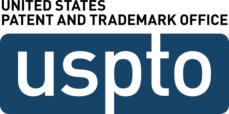



Technivise Blog Article
This is a blog article from Technivise LLC. If you’d like to see other
articles, check out the Blog Index.


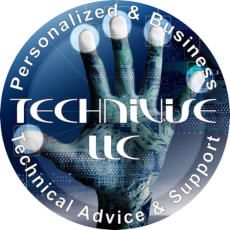
Branding your small
business – 3 Practical
categories to consider for
marketing
One of the first steps to take before addressing marketing and
Online Presence is to think about brand. Like any other subject, it
can be complex in some situations, but focusing on the practical
issues can help you find solutions or better understand the pros
later when you need help.
Technivise always inquiries about brand and branding with Small
and Medium Businesses (SMB) before going too far promoting or
updating their businesses on the Internet and other means of
advertising. Taking pause to consider brand can save time and
money. This blog presents a quick overview of critical concepts in
branding so you’re better prepared to consider it in your Online
Presence.
Brand
A brand can be thought of as a set of quick ways for customers to
recognize and remember your business, encourage loyalty, and
spread the word about your value. Brand is something you want
to protect! Your brand can become bad or negative if you get poor
customer reviews or negative events occur. Your brand can be
stolen or weakened by competitors or other detractors.
Your brand can be any number of elements that work separately
or together. Consider these as end-products of brand, but not
where to start: Logo, Symbol, Icon, Mark, Name, Word, Words,
Font, Colors, Location, Approach, Reputation. Other words
connected to brand are in the “BRAND” graphic here.
Some businesses have a strong brand concept while others do not.
That’s OK. You can add to or update what already exists. That is
called “Re-branding,” but we’ll save that for another time. If you
look around the web about what “brand” means, you’ll get a wide
range of ideas. Specialty branding consultants may cost more than
affordable by a small business. Fortunately, you can do much of
this yourself and Technivise can advise in these areas.
One way to think of branding is in three steps:
1.
Brand Promise – The big picture of your customer
objectives,
2.
Brand Elements – How you express your brand,
3.
Working with Your Living Brand – What you do to use,
support, and protect your brand.
(1) Brand Promise
In the big picture, “Brand Promise” is a
current term for thinking about your
goals before you ever think about a
logo or color scheme. Related terms
are “brand identity” and “brand
positioning statement.” Brand
Promise quickly lets your potential
and existing customers how you will
positively impact their lives – what
you will do and how you will treat them. To do
this, you should also know your customers. What do they need?
What are their preferences? A brand promise should distinguish
your company from others in your field with something customers
care about. It’s about the customer, not you or your company! You
want your customers trust!
It’s worthwhile to think about and capture your Brand Promise in
words or lists and then express them in your branding elements.
Consider what Brand Promise means to you and how to create
statements about your unique value to your customers and the
policies you will have to take care of your customers. Once you
select initial branding elements, ask yourself if they support your
Brand Promise.
(2) Branding Elements
Technivise considers a wide range of elements as part of your
brand, many of them listed below. A particular business may not
adopt all of these, but should consider them all carefully. Others
not listed here may be important for your business.
•
Quality: Differentiation - be different, unique
First consider the quality of being different in all or most of your
branding elements. You don’t have to be completely unique – but
you should have some uniqueness claims. Don’t copy other
companies branding. Look different. Be distinguishable from
your competitors.
To do this, research or have Technivise consider what other
companies are your competitors and which other companies have
already picked branding elements that may be similar to those you
have or are considering. Consider the options and pick the best
path.
•
Company name
If you have not yet named your company, a critical branding
element will definitely be the company name! They should be
simple to remember and may also have some meaning to the
customer. It should stand out from other companies.
If you already have a name for your company, can or should you
alter it? Are you changing the focus or expanding your business?
While it is great to have a unique name nobody else has, if your
business is local or hyper-local, it may not matter as much. Of
course, stay away from copyrighted names, or else you may be
forced to rename your business – and loose much of the branding
investment you’ve built. There are many articles about naming
companies, each with their own suggestions and preferences.
There are even companies to help you name your company! In
naming your company, you may want to also consider the
availability of domain names (see below). Usually doing it yourself
can work out well if you’re careful.
•
Tagline or motto
Your tagline or motto should be a very short phrase that conveys
all or part of your Brand Promise. Some people think your whole
Brand Promise should be conveyed here, but that is often
impractical. Inspire customers with your tagline or motto. Much
is written across the Internet on these topics, so I won’t go into
detail here. You’ll use it throughout your Internet presence and
advertising.
•
Domain name
Because so much business can come via the Internet, considering a
great domain name, “mycompany.com” will be crucial. Finding
one may be highly frustrating because speculators have purchased
and hold onto domain names trying to sell them for high profits.
Goals for a domain name include something simple, easy to
remember, easy to spell, and shorter the better to make it easier
for customers to type.
It would be great to have a domain name that matches your
company name exactly, but that is not always possible. Therefore,
if you’ve not named your company, you may want to consider a
company name at the same time you search for domain names.
If you already have a company name, then finding a domain name
to match that company can take some effort, especially for one
with a common name that might exist in other cities. There are
various techniques to match a company name to a domain name.
You may want to purchase more than one domain name so that
competitors cannot steal your branding with a similar or related
domain name. For instance, if your company is “I Make Big
Unusual Gadgets,” you might want to purchase imbug.com
(something short and easy to type) and
imakebigunusualgadgets.com (your whole company name). They
can both point to the same website.
Variety of “Top Level Domains (TLD),”
sometimes called domain extensions,
used to be quite limited, like “.com,”
“.org,” “.net,” etc. In those past days,
you might want to purchase
“imbug.org” and “imbug.net” in
addition to imbug.com.” Not
anymore – there are too many TLDs
and it would be too costly. Benefit
from many TLDs means that if
“imbug.com” is already taken by someone, you
could
purchase “imbug.biz” and have a good short domain name – at the
risk that someone else owned “imbug.com” and could create brand
confusion. If your company made gadgets for guitars, you could
purchase “imbug.guitars” with likely good success for your
business. The “.com” extension is still a favorite.
•
Logo
A logo is a visual branding of your company that should be seen
consistently everywhere. It will likely be on the Internet, your
business cards, letterhead, invoices, and advertising, television,
newspapers, flyers, vehicle signage, outdoor signage, uniforms, etc.
It also may be placed on giveaway or for-sale logo merchandise,
and on uniforms or t-shirts.
Logos can be very simple to quite complex. This is often a
personal choice of the business owner and may be influenced by
the company activity and the impression you wish to convey to
customers. One should always consider keeping things as simple
as possible.
Consider creating different versions of the same logo because you
may be limited in how it can be displayed or printed in a
particular place. Here are a few ideas:
•
A primary logo may be full color. Color logo versions
work well on your website and business cards or other
full-color printing.
•
Another version of the same logo may be a grayscale.
Grayscale can
work well on
black and white
printers and
photocopies
where color
versions may
print in a visually
unappealing
manner.
•
Another version
may be two-color
(e.g. black and
white). Two-color versions may print well on a wider
variety and less expensive t-shirts, logo merchandise,
and promotional giveaways.
Other elements to consider in your logo is the color scheme and
fonts that might match other aspects of your business or website.
A website design and other advertising may match the color
scheme of your logo. You may also want to consider how your logo
will appear animated in video. For instance, how will it be
revealed or built up in a video that is either inspirational or
representative of your company’s branding, services, or products?
Yet another consideration is how your logo will appear in three
dimensions. This may be through graphics, video animation or
physically 3D printing your logo.
If you produce products, your logo may be placed on the product
along with unique names for those products that also become
branding elements.
•
Fonts – When your business name stands alone
When creating a brand, also consider that the visual appeal of the
company name itself is possible by selection of fonts, size of letters,
and positioning of letters. A good strong approach to branding
should consider how your name stands alone as its own logo after
all other graphics are removed.
There are many existing fonts from which to choose. Usually
selecting one font retains simplicity. Selecting two fonts may add
uniqueness. For example, the first letter of words in your
company name might be different than the others. In an extreme
case, you can commission the creation of a font that nobody else
has for a fairly reasonable cost. Providing ideas and goals to the
font designer can get the process started. The result will be a font
you receive to install on any computer.
•
Colors and Shapes
Some businesses may consider a color, color combinations, and
perhaps set of colored shapes to be a branding element. If this
makes sense for your business, consider how that color scheme
and placement carries across your Internet presence, advertising,
and other communications.
•
Mascot
Some businesses may already have a mascot or consider one as
part of their branding. A mascot may be a graphics cartoon
character, animation, a person, an animal, etc. that represents
your company. This is quite common on television and print
advertising, and it is just as relevant on the multi-media Internet.
A mascot can convey brand to customers in a very strong,
memorable, personable, and emotional way. As examples, they
can be an effective spokesperson for your company or a guide
throughout a website or video that helps your customers know
where to navigate and better understand content.
If you choose to have a mascot, make sure you are in control of it
and can adjust it over time. A live person or specific live animal
will only be available a limited time and may require contractual
negotiation on use of the image of a live or person no longer
available. Cartoon, simulated, or other illustrated characters are a
great alternative, but be careful that the result is classy enough for
your business.
(3) Working with your Living Brand
Once you have a brand concept or a set of brand elements in your
hands, you will have to start using them and integrating them into
your Online Presence and marketing. Here are a few things to
consider.
•
Promote your brand
Get the word out!
This is the obvious
step of including
your branding
elements
appropriately on
your website,
business cards,
letterhead,
advertising, etc.
Other areas
include branded uniforms or clothing for your staff and yourself
and giveaway merchandise. You can put yourself out there and
grow awareness over time or be more aggressive by holding
events, attending shows, having specials, putting out press
releases, and performing other activities to make a bigger splash.
Remember that your brand is also promoted by how you and your
team treat and interact with customers. Your staff should always
know and support the brand through their actions with customers.
“Brand Ambassadors” are those who champion and promote your
brand to others. Encourage brand ambassadors to do this via
social media, bloggers, and enthusiastic customers that promote
reviews.
•
Consistency to avoid confusion
An important way to tidy up your branding is through consistency.
Make sure your brand is presented similarly everywhere.
“Similarly,” means that the particular elements of your brand may
vary slightly across exposure to your customers. For example,
some locations may not have a logo, just the name. Consistency
should carry across the many locations on the Internet, your
business card, letter head, vehicle signage, uniforms, advertising,
etc.
Another element of brand consistency, particularly on the Internet
are the basic facts about your business. In search engine
optimization, this is sometimes called NAP (Name Address Phone
number). You want the basic facts to be consistent across all
listings on the Internet to avoid confusion not only by customers,
but by search engines that may equate inconsistency with lower
ranking on Search Engine Results Pages (SERP). Don’t stop with
NAP… consider consistency at least in your business hours, email
addresses, and motto and tagline, as well as your logo.
•
Reviews and your responses
An increasingly important element of branding and an effect on
branding is the body of reviews on the Internet. Your objective
should be to have the reviews reflect your brand and Brand
Promise. When that cannot happen, your response to uncertain or
negative reviews should reflect your Brand Promise. You might
also respond to positive reviews in a manner reflective of your
Brand Promise and communication style.
Make sure you create this element of brand by encouraging
reviews from your satisfied customers and make sure to perform
“reputation management” by keeping track of your reviews and
responding by thanking some positive reviewers and addressing
concerns or negative reviews.
•
Communication style
Communication style is a subtle but powerful brand element that
is often overlooked. Your website, videos, advertisement,
responses to reviews, etc. can have a style that relates to the
personality of your business and how you will interact and treat
your customers. Is it formal? Informal? Easy going? Engaging?
Legal or complex? Technical? Artistic? Upbeat? Helpful and
engaging? Easy? Difficult? Reassuring?
Consider what your customers would want and how your message
comes across in person, through visual elements, and via the
written word. Attempt to have a similar communication style
across information you present to your customers.
•
Interaction style and channels
While some may argue it’s not a brand element, how you interact
with your customers becomes a practice at your business that can
enhance and support your brand. It can also become elements of
your company policy and a familiar attribute of your business
seen and appreciated by your customers. Consider how and when
you want to use interaction approaches such as these:
•
Fixed landline phone and cell phone,
•
in-person meetings,
•
Email, web contact forms,
•
Blogs,
•
Social media,
•
Directories,
•
Video conferencing,
•
Seminars,
•
Training sessions,
•
Gatherings, parties, celebrations.
How you present your brand elements, brand promise and having
some consistency across these approaches can bolster your brand.
•
Protecting your brand
There are many ways to consider protecting brand elements once
they are established. Protect from what? Other companies or
individuals may poach or steal your brand one way or another
after you’ve invested in it. It’s rare, but it can happen. What if
another person opens up a business to go after your customers
with a company by the same name? That could be painful.
Some approaches vary from simple to complex and protections
vary from weak to strong. Here are a few steps:
•
Buying domain names.
•
Registering your business with your local state
organizations, such as Secretary of State, State
Corporation Commission, city business registrations,
etc.
•
Trademarks and Trade Names can be registered
federally with USPTO.gov.
•
Keeping an eye out for others who may use your brand.
Stop them!
Buying the relevant domain names is a first step and frequent
example. However, doing so does not create a trademark. In fact,
you could be forced to give up your domain name if you register a
domain already trademarked by someone else.
Registering your local business with your city and state
government Secretary of State’s office and State Corporation
Commission is a good step
for local protection and
important licensing. It also
legally documents your first date and usage with your brand
elements. You can also register trademarks and service marks
with this office in your local state, often easily and for little money.
This usually has to be done once your business is up and running.
For broader federal protection, you may want to trademark your
business brand including words, phrases, slogans, symbols, logos,
sound, or designs. Service Marks are similar to Trademarks that
protect the source of a service.
Copyrighting some your content can be
a lengthy and expensive process.
Information can be found at The United
States Patent and Trademark Office
(uspto.gov). USPTO.gov allows you to
search for existing trademarks in their USPTO database.
Processing trademarks through USPTO can be quite complex and
will likely require a lawyer.
Now that you have branding basics in mind, what’s your next step?
Contact Technivise if you need ideas or help with your brand and
promoting it to your customers.
